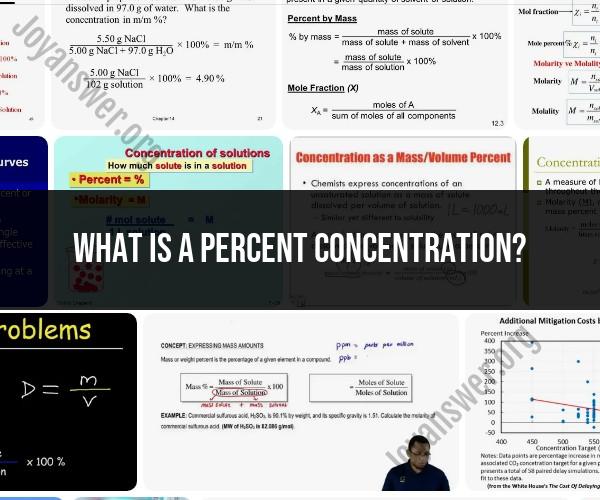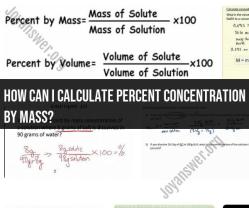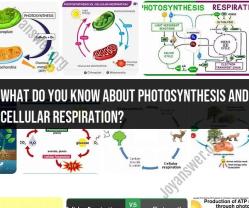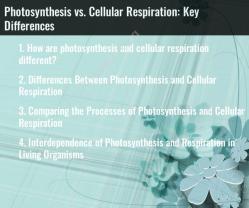What is a percent concentration?
Percent concentration, often referred to as simply "percent," is a way to express the amount or proportion of one substance (the solute) in a solution or mixture, usually in relation to the total quantity of the solution or mixture (the solvent and solute combined). It is expressed as a percentage, which is a ratio multiplied by 100. Percent concentration is a common unit of measurement in chemistry and other fields.
The formula for calculating percent concentration is:
Here's a breakdown of this formula:
- "Amount of Solute" is the quantity of the substance being measured or dissolved in the solution. This is typically measured in units such as grams, milligrams, moles, etc.
- "Amount of Solution" is the total quantity of the mixture, including both the solute and the solvent. This is also measured in the same units as the amount of solute.
Percent concentration can be used to express various types of measurements, such as:
Mass Percent: This is used to indicate the proportion of the mass of the solute in the solution. It's calculated by dividing the mass of the solute by the total mass of the solution and then multiplying by 100.
Volume Percent: In cases where the solute and solvent are both in a liquid state, volume percent is used. It represents the volume of the solute in a given volume of the solution, calculated in the same way as mass percent.
Mole Fraction: Mole fraction expresses the number of moles of the solute relative to the total number of moles in the solution. It is another way of measuring concentration, especially in chemical reactions and colligative properties.
Molarity (Molar Concentration): Molarity represents the number of moles of solute in one liter of solution. It is widely used in chemistry for making solutions with precise concentrations.
Percent concentration is a flexible and widely applicable way to quantify the relative presence of one substance in a mixture. It's used in chemistry, pharmacy, medicine, food science, and various other scientific and industrial fields to describe the strength or concentration of a particular substance within a solution or mixture.
Demystifying Percent Concentration: A Comprehensive Overview
Percent concentration is a measure of the amount of solute present in a solution, expressed as a percentage of the total mass or volume of the solution. It is a commonly used unit of concentration in chemistry, industry, and manufacturing.
Percent concentration can be calculated using the following formulas:
Mass percent:
Mass percent = (mass of solute / mass of solution) * 100%
Volume percent:
Volume percent = (volume of solute / volume of solution) * 100%
where:
- Mass of solute is the mass of the substance that is dissolved in the solution.
- Volume of solute is the volume of the substance that is dissolved in the solution.
- Mass of solution is the mass of the mixture of the solute and the solvent.
- Volume of solution is the volume of the mixture of the solute and the solvent.
The Role of Percent Concentration in Various Fields
Percent concentration plays an important role in a variety of fields, including:
- Chemistry: Percent concentration is used to express the concentration of solutions in chemistry, especially for solutions of solids dissolved in liquids.
- Industry: Percent concentration is used to express the concentration of solutions in industry, such as in the production of food, beverages, and pharmaceuticals.
- Manufacturing: Percent concentration is used to express the concentration of solutions in manufacturing, such as in the production of paints, coatings, and adhesives.
Interpreting and Utilizing Percent Concentration Data
When interpreting and utilizing percent concentration data, it is important to consider the following factors:
- The type of percent concentration: Percent concentration can be expressed as mass percent or volume percent. It is important to know which type of percent concentration is being used when interpreting data.
- The concentration of the solution: The concentration of the solution can have a significant impact on its properties. For example, a more concentrated solution of acid will be more corrosive than a less concentrated solution of acid.
- The solubility of the solute: The solubility of the solute is the maximum amount of solute that can be dissolved in a given amount of solvent at a given temperature. If the concentration of the solution is higher than the solubility of the solute, the excess solute will precipitate out of the solution.
Practical Examples and Scenarios Involving Percent Concentration
Here are some practical examples and scenarios involving percent concentration:
- A chemist is preparing a solution of hydrochloric acid for an experiment. The chemist needs a solution that is 10% hydrochloric acid by mass. To prepare this solution, the chemist would need to mix 10 grams of hydrochloric acid with 90 grams of water.
- A food manufacturer is producing a batch of orange juice. The manufacturer needs to ensure that the orange juice has a consistent concentration of sugar. To achieve this, the manufacturer would measure the percent concentration of sugar in the orange juice using a refractometer.
- A paint manufacturer is producing a batch of white paint. The manufacturer needs to ensure that the paint has a consistent concentration of titanium dioxide, which is the pigment that gives the paint its white color. To achieve this, the manufacturer would measure the percent concentration of titanium dioxide in the paint using a gravimetric method.
The Language and Measurement of Concentration Percentages
The language and measurement of concentration percentages can be complex and confusing. It is important to understand the following terms and concepts:
- Solute: The solute is the substance that is dissolved in the solution.
- Solvent: The solvent is the substance that dissolves the solute.
- Solution: The solution is the mixture of the solute and the solvent.
- Mass percent: Mass percent is a unit of concentration that expresses the mass of a solute in a solution as a percentage of the total mass of the solution.
- Volume percent: Volume percent is a unit of concentration that expresses the volume of a solute in a solution as a percentage of the total volume of the solution.
Percent concentration can be measured using a variety of methods, including:
- Refractometry: Refractometry is a method of measuring the concentration of a solution by measuring its refractive index.
- Gravimetry: Gravimetry is a method of measuring the concentration of a solution by precipitating the solute out of the solution and weighing it.
- Volumetric analysis: Volumetric analysis is a method of measuring the concentration of a solution by titrating it with another solution of known concentration.
By understanding the concept of percent concentration and how to measure it, you can better interpret and utilize percent concentration data in a variety of fields and applications.













